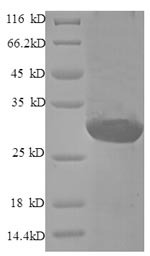Inserting the gene encoding the human Endothelin-1 (EDN1) (53-73aa) fused with the N-terminal GST-tag gene into a plasmid vector results in the creation of recombinant plasmid, which is introduced into E.coli cells. E.coli cells that can survive in the presence of a specific antibiotic are selected, indicating successful uptake of the recombinant plasmid. The E.coli cells containing the recombinant plasmid are cultured under conditions promoting the expression of the gene of interest. After expression, affinity purification is used to isolate and purify the recombinant human EDN1 protein from the cell lysate. Denaturing SDS-PAGE is then applied to resolve the resulting recombinant human EDN1 protein, revealing a purity level exceeding 90%. Its activity has been validated through its binding ability with EDNRB protein in a functional ELISA.
EDN1 is a super important molecule that sends signals in the body, affecting things like how the face and heart develop, as well as how cells grow and multiply [1]. It works by connecting with a specific receptor called Ednra, which helps shape certain bones in the face, like the lower jaw [1]. EDN1 is made in specific tissues in the throat and signals to special cells called cranial neural crest cells, which also have receptors for EDN1 [2]. It's a big player in conditions where the baby doesn't grow enough in the womb due to low oxygen levels [3]. Plus, it's involved in how our skin makes pigment, by encouraging the release of more EDN1 and promoting pigment production [4]. Overall, EDN1 influences both how the face and heart form during development and how our bodies function as adults by connecting with receptors on cells and setting off different reactions [5].
References:
[1] S. Nair, W. Li, R. Cornell, & T. Schilling, Requirements for endothelin type-a receptors and endothelin-1 signaling in the facial ectoderm for the patterning of skeletogenic neural crest cells in zebrafish, Development, vol. 134, no. 2, p. 335-345, 2007. https://doi.org/10.1242/dev.02704
[2] C. Miller, M. Swartz, P. Khuu, M. Walker, J. Eberhart, & C. Kimmel, Mef2ca is required in cranial neural crest to effect endothelin1 signaling in zebrafish, Developmental Biology, vol. 308, no. 1, p. 144-157, 2007. https://doi.org/10.1016/j.ydbio.2007.05.018
[3] L. Thaete, T. Jilling, S. Synowiec, S. Khan, & M. Neerhof, Expression of endothelin 1 and its receptors in the hypoxic pregnant rat1, Biology of Reproduction, vol. 77, no. 3, p. 526-532, 2007. https://doi.org/10.1095/biolreprod.107.061820
[4] P. Park, T. Lee, & E. Cho, Substance p stimulates endothelin 1 secretion via endothelin-converting enzyme 1 and promotes melanogenesis in human melanocytes, Journal of Investigative Dermatology, vol. 135, no. 2, p. 551-559, 2015. https://doi.org/10.1038/jid.2014.423
[5] A. Tavares and D. Clouthier, Cre recombinase-regulated endothelin1 transgenic mouse lines: novel tools for analysis of embryonic and adult disorders, Developmental Biology, vol. 400, no. 2, p. 191-201, 2015. https://doi.org/10.1016/j.ydbio.2015.01.027"






